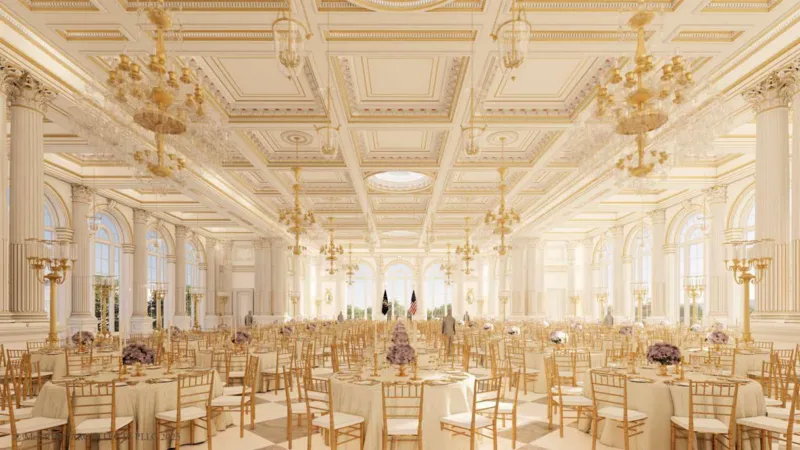
 A rendering of the new 650-person ballroom in a new 90,000 sq ft building/WHITE HOUSE
A rendering of the new 650-person ballroom in a new 90,000 sq ft building/WHITE HOUSEConstruction is already underway on President Donald Trump’s $250 million neoclassical ballroom at the White House.
This is a project that has stunned preservationists, energized loyalists, and reignited debates over presidential legacy.
Rising from the rubble of the demolished East Wing, the ballroom will be the most significant architectural addition to the executive mansion in over a century.
But beyond the gold-leaf renderings and donor-funded price tag lies a deeper story: one of power, spectacle and the contested meaning of American symbolism.
A ballroom fit for a brand
The ballroom, which will span over 90,000 square feet, is designed to host state dinners, diplomatic galas and large-scale ceremonial events.
According to renderings released by the Trump administration, the space will feature 30-foot gilded ceilings with hand-painted frescoes, imported Italian marble floors and, a retractable stage and orchestra pit.
It will also feature a private mezzanine gallery for VIPs and family.
Initial plans put capacity at 650 guests but Trump made a change to the same, announced that there would be room for 999 people.
Architecturally, the design draws from Beaux-Arts and neoclassical traditions, echoing the grandeur of Versailles and the palatial wings of Buckingham Palace.
But critics say it also bears the unmistakable imprint of Trump’s personal aesthetic; opulent, theatrical and unapologetically grandiose.
Renderings released by the White House suggest a strong resemblance to the gilded ballroom at Mar-a-Lago, Trump’s private club and home in Palm Beach, Florida.
The East Wing, demolished
To make way for the ballroom, the East Wing, home to the First Lady’s offices, the press briefing room and the historic entrance used by thousands of White House visitors, has been razed.
Demolition began quietly in October 2025, with construction crews working under tight security and limited press access.
The White House said some demolition was needed because the East Wing is being modernised as part of the ballroom project.
President Trump said on July 31, that the White House itself would remain intact as the ballroom was going up.
“It won’t interfere with the current building. It will be near it but not touching it. And pays total respect to the existing building, which I’m the biggest fan of,” he said.
Who’s paying?
The $250 million price tag, roughly Sh32 billion, has raised eyebrows in a time of economic uncertainty. However, the White House insists that the project is entirely privately funded.
According to a statement from the Office of the President, the ballroom is being financed through a mix of “many generous Patriots, Great American Companies, and, yours truly”.
The White House promised to release information on which individuals and corporations have pledged or donated money and had invited some of the donors to an East Room dinner.
Some $22 million for the project came from YouTube, a Google subsidiary, as part of a recent settlement for a 2021 lawsuit Trump brought against the company.
The White House also has not said how much of his own money Trump is contributing.
Critics have warned that this financing model could lead to corruption.
"The companies giving the money are clearly doing so to gain favor with the government and promote their brand with federal officials," Richard Painter, professor of corporate law and former chief ethics lawyer in the George W. Bush administration between 2005 and 200 told DW.
Others, according to DW, see the renovation as problematic.
"Is it fair for an administration to pursue expensive, mainly aesthetic projects while ordinary US citizens face financial strain?" Davina Hurt, director of the government ethics program in the Markkula Center for Applied Ethics at Santa Clara University in California asked.
 A rendering shows what the outside would look like of the renovated East
Wing of the White House. The right portion of the building is the East
Wing/WHITE HOUSE
A rendering shows what the outside would look like of the renovated East
Wing of the White House. The right portion of the building is the East
Wing/WHITE HOUSEA legacy in marble
For Trump, the ballroom is more than a venue, it is a legacy project.
He has described the project as “new, big and beautiful”.
Trump insists that, for 150 years, the US government has lacked and wanted, space to host large receptions at the White House.
"I am pleased to announce that ground has been broken on the White House grounds to build the new, big, beautiful White House Ballroom," Trump wrote on his Truth Social network in October.
In July, the White House said that is why, "President Donald J. Trump has expressed his commitment to solving this problem on behalf of future administrations and the American people”.
What comes next?
The White House has said the ballroom will be ready for use well before Trump’s term ends in January 2029, an ambitious timeline.
The projected timeline is 18 to 24 months, placing the anticipated completion date between late 2027 and early 2028.
This timeline is considered ambitious given the scale of the project, which includes demolishing the existing East Wing and constructing a 90,000-square-foot neoclassical ballroom with advanced infrastructure and ceremonial features.
Past White House renovations

The
people’s house, reimagined
At its core, the Trump ballroom raises a fundamental question: Who is the White House for?
Is it a stage for presidential performance? A sanctuary of democratic humility? Or, as Trump seems to believe, a palace for the people, so long as they applaud?
As construction cranes rise over Pennsylvania Avenue, the answer remains suspended in scaffolding.


















